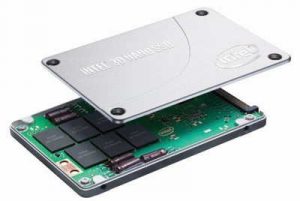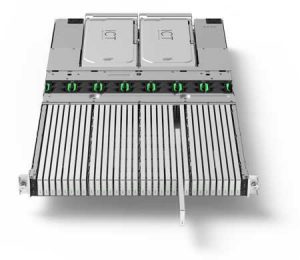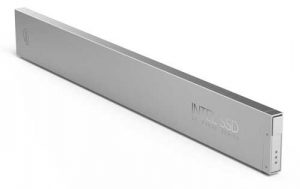Flash Memory Summit: Intel Inaugurates New Small SSD Form Factor, Ruler
Able to pack 1PB in 1U server rack in future
This is a Press Release edited by StorageNewsletter.com on August 16, 2017 at 2:27 pmIntel Corp. announces data center storage advances.

These technologies advance data center storage and deliver solutions to meet the challenges presented by the growing reliance on data.
System with ‘Ruler’ form factor SSD

They include:
-
‘Ruler’ form factor for the firm’s SSDs, an all-new SSD form factor enabling up to 1PB of storage in a 1U server rack in the future.
-
Advanced dual port portfolio (1): Optane technology dual port SSDs and company’s 3D NAND dual port SSDs for mission-critical applications.
-
Updated SATA family of SSDs for data center, targeted at HDD replacement.
“We are in the midst of an era of major data center transformation, driven by Intel. These new ‘ruler’ form factor SSDs and dual port SSDs are the latest in a long line of innovations we’ve brought to market to make storing and accessing data easier and faster, while delivering more value to customers,” said Bill Leszinske, VP, non-volatile memory solutions group, and director, strategic planning, marketing and business development, Intel. “Data drives everything we do – from financial decisions to virtual reality gaming, and from autonomous driving to machine learning – and Intel storage innovations like these ensure incredibly quick, reliable access to that data.“
Intel ‘Ruler’ form factor for SSDs

‘Ruler’ form factor for firm’s SSDs
The ‘ruler’ form factor, so-called for its long, skinny shape, shifts storage from the legacy 2.5-inch and 3.5-inch form factors that follow traditional HDDs, and the add-in card form factor, which takes advantage of PCIe card slots, and delivers on the promise of non-volatile storage technologies to eliminate constraints on shape and size. This form factor delivers the most storage capacity for a server, with the lowest required cooling and power needs. The next-generation ‘ruler’ form factor SSDs using the company’s 3D NAND technology will enable up to 1PB in a 1U server – enough storage for 300,000 HD movies, or about 70 years of nonstop entertainment. Both Optane SSDs and 3D NAND SSDs in the ‘ruler’ form factor will come to market in the near future.
Dual port SSDs
Dual port company’s Optane SSDs and 3D NAND SSDs offer critical redundancy and failover, protecting against multiple paths to failure for mission-critical and HA applications. Dual port SSDs replace SAS SSDs and HDDs and, with new storage technologies, deliver more IO/s, more bandwidth and lower latency than SAS SSDs. Dual port SSD DC D4500, D4502 and D4600 Series will be available starting in 3Q17.
SATA SSDs for data centers
The firm’s SSD DC S4500 and S4600 Series combine a company-developed SATA controller, SATA firmware and the industry’s high density 32-layer 3D NAND. These storage-inspired SSDs preserve legacy infrastructure, ensuring a simple transition from HDD drives to SSDs, while enabling data centers to reduce storage cost, increase server efficiency and minimize service disruptions. The new members of the second-generation firm’s 3D NAND SSD family are available.
Intel Optane Technology Webcast
An earlier webcast, hosted by Leszinske and Laura Crone, VP and director, NSG end-user solutions marketing, Intel, featured customers outlining how Optane technology is driving advancements in health care, transforming how transactions occur, enabling real-time analytics and capitalizing on the performance of Xeon CPUs.
(1) World’s Most Advanced Dual Port Portfolio. Source – Intel. Based on comparison of Intel, Samsung, HGST and Toshiba dual port SSD portfolios. Intel dual port portfolio plans as of August 7, 2017 spans Intel 3D NAND SSDs and Intel Optane SSDs. Intel SSD DC D4500, D4502 and D4600 are Intel’s 2nd generation of PCIe SSDs and are available for shipment. Dual port Intel Optane SSDs are shipping now to select customers for validation and will be more broadly available by the end of 2017. Inclusion of Intel Optane SSDs brings the world’s most responsive data center SSD (Responsiveness defined as average read latency measured at Queue Depth one during 4k random write workload. Measured using FIO 2.15. Common configuration Intel 2U Server System, OS CentOS 7.2, kernel 3.10.0-327.el7.x86_64, CPU 2xXeon E5-2699 v4 @ 2.20GHz (22 cores), RAM 396GB DDR @ 2133MHz. Intel drives evaluated – Intel Optane SSD DC P4800X 375GB and Intel SSD DC P3700 1600GB. Samsung* drives evaluated – Samsung SSD PM1725a, Samsung SSD PM1725, Samsung PM963, Samsung PM953. Micron drive evaluated – Micron 9100 PCIe NVMe SSD. Toshiba* drives evaluated – Toshiba ZD6300. Test – QD1 Random Read 4K latency, QD1 Random RW 4K 70% Read latency, QD1 Random Write 4K latency using FIO 2.15) into the portfolio.












 Subscribe to our free daily newsletter
Subscribe to our free daily newsletter
